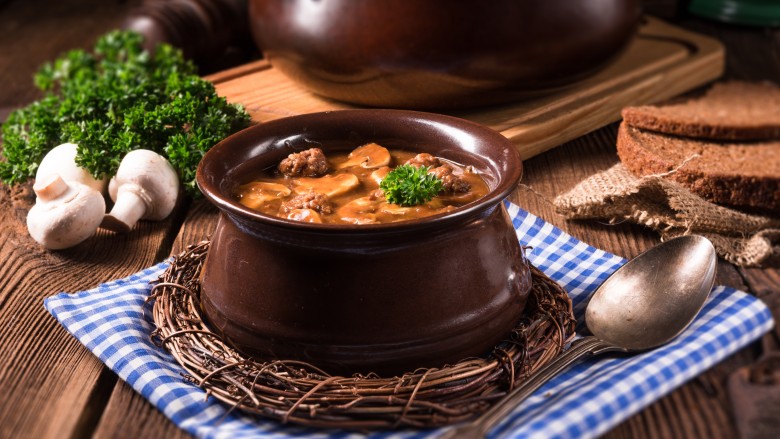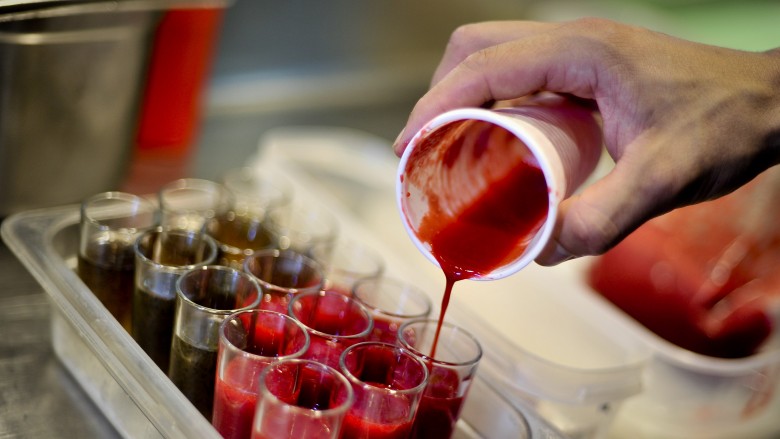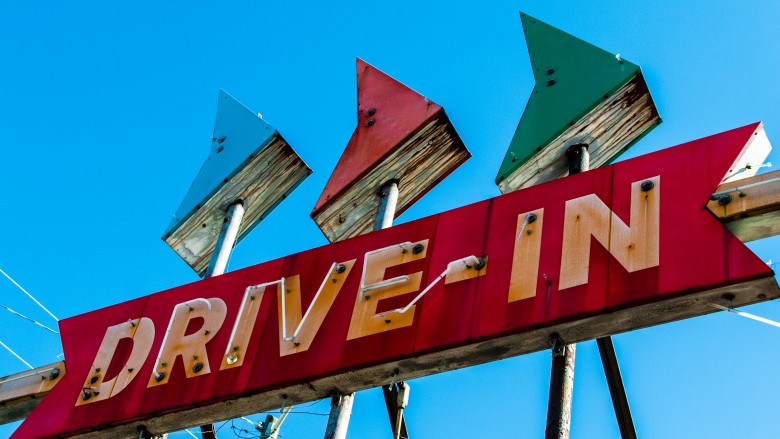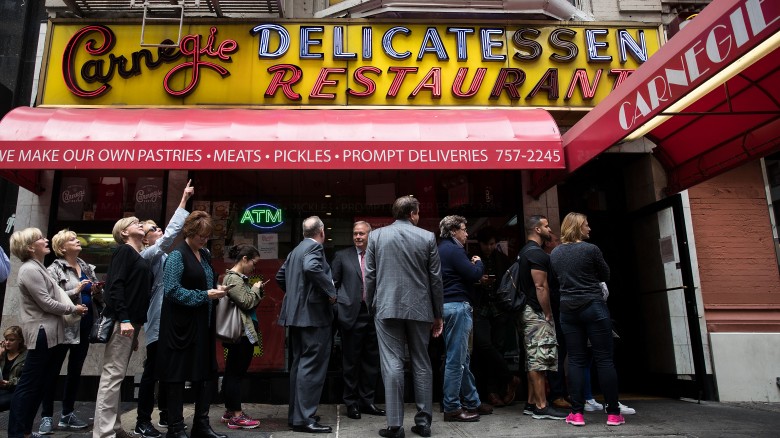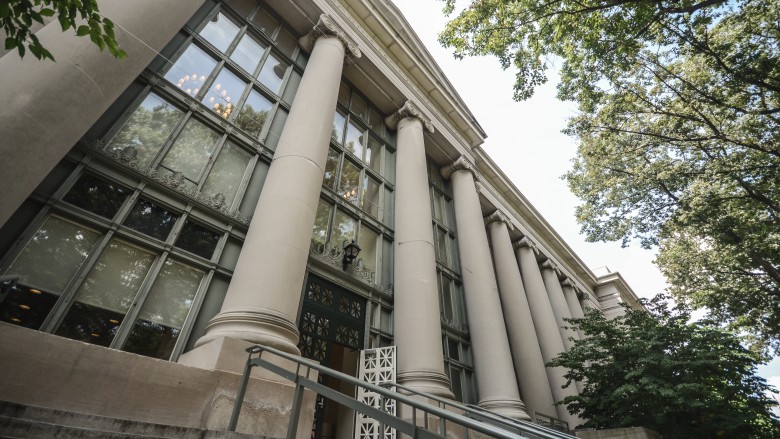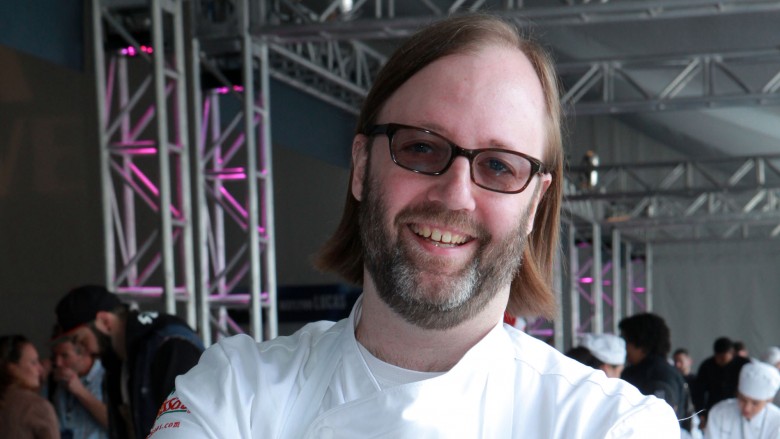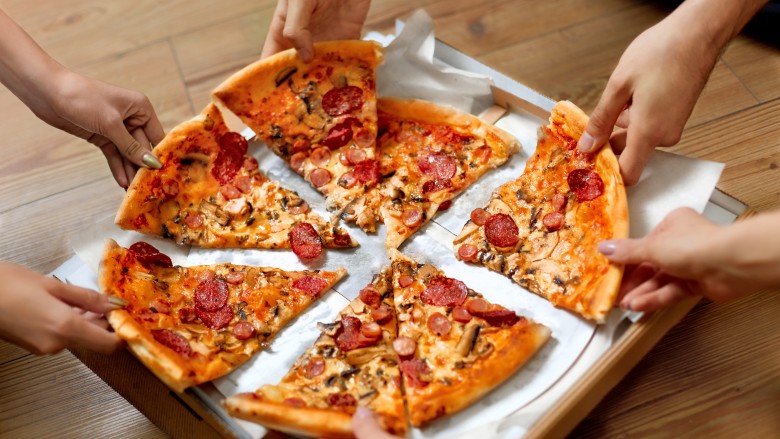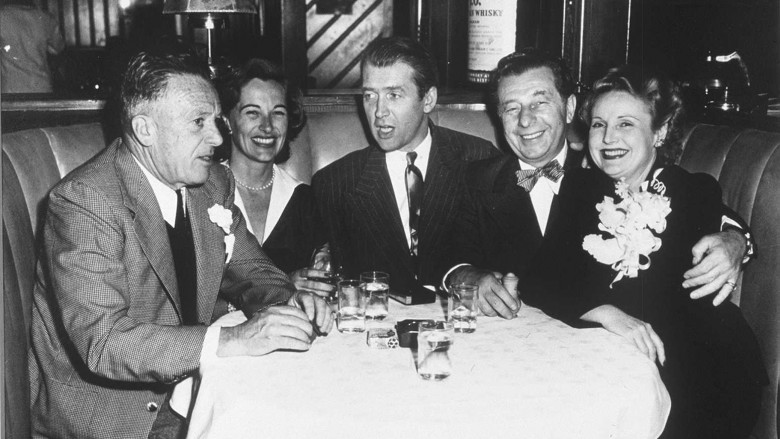Amazing Restaurants You'll Never Get To Visit
The best restaurants, diners, pubs and bars have a soul and culture of their own, creating a unique space and time. Think about your favorite place to stop for a meal. What is it that makes it so special and keeps you going back, time after time? We can all remember some greasy spoon, noodle shack, or haute cuisine joint that touched our lives in some way, and then one day was gone forever. Would it be weird to wish for a time machine just to go back and eat somewhere one more time? I hear dodo is delicious. For those against eating extinct animals, here are some other options for culinary journeys into the past. These restaurants were something to behold in their prime, but now, all we have are memories and stories.
Atomic Cafe
In 1946, Ito and Minoru Matoba moved to the Little Tokyo area of Los Angeles after being released from an internment camp and opened the Atomic Cafe. Because African Americans had moved into the area during the war, the environment was cosmopolitan and racially mixed, which was rare at the time. The Matobas responded with a menu composed of eclectic "Japanese Chinese American" cuisine with noodles and hamburgers coexisting nicely. When asked why he chose the Atomic name so soon after the nuclear strikes against Hiroshima and Nagasaki, Mr. Matoba replied, "People will always remember the atomic bomb. Maybe they will always remember the Atomic Cafe."
Atomic Cafe entered a wild new phase in the late 1970s under the influence of Matoba's daughter, Nancy Sekizawa, otherwise known as Atomic Nancy, who introduced a punk aesthetic to the restaurant. A combination of "the best noodles in town" and a unique jukebox playing classic rock and crooners, local punk press albums, and Japanese 45s attracted a wild clientele. According to Sekizawa, "Most punk rockers were misfits and that's why I felt like — I felt pretty good. I didn't feel like I ever blended, anywhere. [The Atomic Cafe] was a home for the ones that didn't feel like they ever had a home." Atomic Nancy helped create the inclusive but raucous atmosphere, slinging bowls of noodles to patrons on a pair of roller skates and serving as the restaurant DJ every night.
The Atomic Cafe closed in 1989, and its former location was later demolished to make way for a subway station. When asked if a place like Atomic Cafe could exist today, Atomic Nancy was skeptical. "We did everything against all the codes, citations, we broke them then, and there would be such severe consequences today," she said. Which is a pity, because the place sounds like it was a blast.
Julien's Restorator
While 18th-century Boston had its fair share of taverns and boardinghouses serving food, Julien's Restorator was the first which modeled itself after the newfangled "restaurants" popular in France. Founded in July, 1793, by Jean Gilbert Julien, a former chef for the Archbishop of Bordeaux who fled to America following the French Revolution, the eatery promoted the healthful and restorative aspects of its menu.
Unlike most eateries of the time which offered buffet-style menus at a set price, at the Restorator patrons would have the rare chance to peruse a menu and only pay for the items they ordered. Julien was famous for soups, broths, pastries, beef, bacon, and poultry, and became known as the Prince of Soup. One advertisement from 1797 proclaimed a bumper catch of green sea turtles and said Julien would "kill one every day" to furnish his clients with refreshing turtle soup.
Julien oversaw the restaurant until his death in 1805, and the Restorator was later run by his wife for a decade until it was sold on to another entrepreneurial French chef. Sadly for those of us in need of refreshing viands, the building was torn down in 1824.
El Bulli
History was made for an isolated Barcelona restaurant, El Bulli, in 1983 when young naval recruit Ferran Adria decided to spend his summer leave working there. While mostly interested in drinking and womanizing, Adria was a quick learner. He returned after his military service and became head chef in 1987, when he embarked on a cooking philosophy defined by the adage "Creativity means not copying." Adria decided to close the restaurant during the winter months to focus on experimentation, the fruits of which were some of the first deconstructed dishes and super-light "foam" mousse. Adria became the founder of "molecular gastronomy," though he hates the term.
Adria was proclaimed by acclaimed chef Joel Robuchon as the best chef on the planet, to howls of protest from French culinary circles. The restaurant became highly sought after, and at the height of its popularity, El Bulli was said to receive over a million reservations requests with only 8,000 lucky souls getting a table.
The restaurant was closed in 2011, reflecting Adria's desire to focus on culinary experiments without the difficulties of satisfying customers at the same time. Many of his innovations have been copied the world over, which only makes you wonder what secrets are hiding in El Bulli today.
Ameche's Drive-In Restaurant
In the car-crazy culture of America in the 1950s and 60s, the drive-in was king. In Baltimore the most iconic was opened in 1956 when Baltimore Colts star Alan Ameche was roped into the restaurant business by fellow player and former chef Gino Marchetti. The franchise became known for its Powerhouse burger and as a prime location for young people to show off their cars and attract members of the opposite sex. The slogan "I'll meetcha at Ameche's" became a popular catch-phrase.
While beloved, being a patron is said to have been a somewhat harrowing experience. After parking in place, a shrill voice would demand orders from customers and if they were not quick enough they'd be told to vacate immediately. As many of the clientele were poor young people, the waitresses knew not to expect tips, but also wouldn't hesitate to dump a milkshake into someone's lap if they gave them any lip.
Like other venues of this type, the drive-in gradually faded away in the late 1960s. Still, many older Baltimoreans have fond memories of their times eating burgers in a parking lot in their parents' cars showing off for the girls.
Carnegie Deli
For decades after it opened in 1937, this deli on New York's Seventh Avenue across from Carnegie Hall was just one deli among many in the theater district serving Jewish classics like matzo ball soup and pastrami sandwiches. Things changed in the 1970s when a reviewer for The New York Times acclaimed the deli as having the best pastrami in the city and a patrons flocked there, including Broadway and movie stars. By the time it appeared in Woody Allen's 1984 film Broadway Danny Rose it was considered a New York institution.
Carnegie Deli served ludicrously large "gargantuan sandwiches" to its hungry customers. The pastrami sandwich was a six inch tall beast with a pound of hot meat held precariously between two thin slices of rye bread. Carnegie prided itself on its tender meat, and the deli embraced the touristy image over the years, presenting diners with goofy promotional video What a Pickle: The World's Greatest Deli Musical played on loop.
Things turned south for the iconic deli in 2015 when it was shut down for ten months after utility workers discovered it was stealing gas, after which a court ordered the restaurant pay over $2 million in back wages to the staff. Soon after, owner Marian Harper went through a messy divorce with her husband, who (allegedly) stole the recipes for their pastrami and cheesecake and shared it with his mistress. Carnegie Deli closed for good in December 2016. While branches remain open in Las Vegas and Bethlehem, Pennsylvania, you'll have to go somewhere else to get stuffed with pastrami in New York City.
Pith
After cooking for his roommates, Columbia University senior Jonah Reider decided to open his own restaurant in his dorm room with an online sign-up sheet and initially low expectations. He didn't expect to go viral after a student newspaper published an article about it, but soon the news had reached mainstream media and he found himself fully booked for months on end, far longer than he could possibly fulfill. He was featured in a New Yorker article and even appeared on The Late Show to feed Stephen Colbert leftovers. Against all the odds, the feedback for his creations was quite popular, garnering a few five star reviews on Yelp and rave reactions from professional reviewers to boot.
To avoid violating university guidelines, Reider did not make profit from his restaurant, charging only for the cost of ingredients. But the powers that be in the on-campus housing were not pleased by the initiative and in May 2016 his lease at the dormitory was terminated for "ongoing issues." So there's no hope for those curious in trying a competently prepared multi-course meal in the comfort (?) of a dorm room, but Reider managed to get a gig at Chicago restaurant Intro where he continued to hold his communal "supper clubs."
WD-50
When Wylie Dufresne opened WD-50 in 2003, the reactions were a bit confused. Dufresne described his menu as "American cuisine" but was dedicated to pushing the boundaries of cutting edge cuisine with offerings like noodles made from shrimp and aerated foie gras. The team at WD-50 often worked from stray musings from Dufresne's food journal like, "Can you braise couscous in coffee milk?" and "What comes out when you put wine through a dehydrator?" The results varied, but many of the successes ended up on the menu. Speaking of the menu, it only listed ingredients with no indication of how the meal was prepared, leading to appetizers like "Butternut squash, sherbert, Earl Grey, tapioca".
Perhaps one of his most iconic dishes was the eggs Benedict, developed after perfecting a method of frying Hollandaise sauce. Their take on it was characteristically unorthodox, involving seasoned egg yolks cooked in plastic sleeves, wisps of bacon created over several days of freezing, slicing and baking, a fried cube of Hollandaise sauce held together with gelatin and starch, and an English muffin ground into a powder. While not resembling any other eggs Benedict, the dish became extremely popular, dubbed the restaurant's "Stairway to Heaven," which everyone wanted to try.
After 11 years of offering truly unique experiences, the restaurant was forced to close in 2014 when the building owner sold to a developer who wished to place a new building on the site. After briefly considering continuing to run the restaurant in the midst of an active construction site, Dufresne decided things were over. For the time being, if you want to try out WD-50's iconic and confusing food, you'll need to track down a copy of Dufresne's cookbook.
Pizza Showtime
Chuck E. Cheese is famous not just for those lucky enough to have been there but also those who merely watch from afar. But America didn't always have a monopoly on family eateries with dubious food and horrifying animatronic characters. For a brief golden period in the 1980s, Perth, Australia had its own such venue: Pizza Showtime. Located in the Grand Theatre built in 1913, this place had it all: pizza, video games and a cast of robotic Australian characters including the singing Koala Sisters, Ringo Dingo, a horse named Ned Kelly, and one incongruous black bear from Tennessee, for some reason.
Regrettably, Pizza Showtime was closed in the mid-80s and the Grand Theatre itself was demolished in 1990. The robots were said to have been dismantled and sent to a company in Sydney, though their ultimate fate is unknown. I like to think they are sitting forgotten in a warehouse somewhere waiting for a stray bolt of lightning to bring them to life.
Chasen's
Dave Chasen was a Broadway actor and vaudeville comedian who moved to LA to make it big in the pictures, which he didn't. But his cooking was a success, so in 1936 he opened a restaurant serving chili and ribs to the starlets and shakers of Hollywood. Chasen later expanded the menu after director Frank Capra complained of having to eat chili and ribs all the time, adding items like hobo steak and deviled beef bones. The Hollywood elite were attracted to the private, club-like atmosphere of Chasen's and even J. Edgar Hoover frequented the restaurant, which was off limits to the press. The restaurant famously accepted no credit cards: well-known patrons could simply have the bill sent to their house. Those patrons who weren't somebody suffered a far more contemptuous attitude from the waiters, though the food and stargazing is said to have made up for it, a bit.
There are countless fascinating stories from Chasen's which may or may not be true. Alfred Hitchcock regularly falling asleep at his table. Ronald Reagan proposing to Nancy. Jimmy Stewart throwing a bachelor party featuring two midgets in diapers. Humphrey Bogart and Peter Lorre getting drunk and stealing the restaurant safe. Donna Summer writing "She Works Hard For the Money" after hearing the line from a bathroom attendant.
After Chasen died in 1973, his wife Maude carried on attracting newer stars like Sharon Stone, John Travolta and Quentin Tarantino until the final closure in 1995. The building was finally torn down to make way for a Bristol Farms supermarket, though one small section remains standing and offers a chili stall. It's highly unlikely they deliver to any movie sets, though they do take credit cards.


